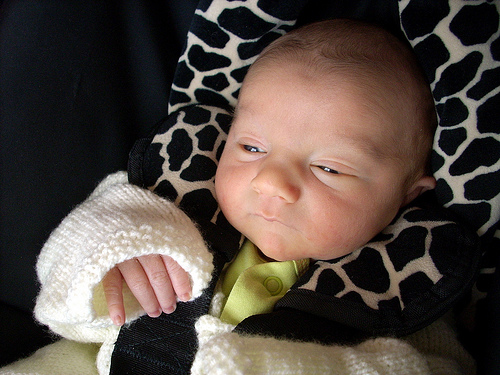Over 1/3 of 2011 child crash fatalities were without car seats or seatbelts
As Child Passenger Safety Week (September 15 through September 21) draws to a close, the Department of Transportation’s National Highway Traffic Safety Administration (NHTSA is drawing attention to a shocking statistic: Over a third of children under age 13 who were killed in 2011 in passenger vehicle crashes were not sitting in car seats or wearing seat belts.

Children outside of carseats constitute over a third of child fatalities from car accidents. From Simon Yeo.
Car and vehicle crashes are a major — and leading — cause of death among kids. Every day in 2011, nearly two children under age 13 were killed as a result of a car crash. During that same timeline, 338 children were injured while riding in SUVs, pickups, vans, and cars. The bigger the car, it seems, the greater the likelihood of unrestrained fatalities. Among the children killed, reports the NHTSA, “the percentage of unrestrained fatalities, with no car seat or seat belt, varied by vehicle type, with greater percentages of unrestrained fatalities occurring in larger vehicles.” Those percentages break down as follows:
- SUVs: 55 percent
- Pick-ups: 43 percent
- Vans: 40 percent
- Cars: 24 percent
Drivers may feel that their children passengers are safe in larger vehicles. However, as NHTSA Administrator David Strickland explains, “Regardless of the size of the vehicle, the age of the child or the length of the trip, children should always be properly restrained in a car seat, booster or seat belt. Car seats, when correctly installed and used, provide proven life-saving and injury-reducing benefits for child passengers.”
It has been well-documented that seatbelts save lives. Between the years of 1975 and 2011, according to NHTSA estimates, about 10,000 lives were saved by child restraints for kids under the age of 5 in passenger vehicles, with more than 260 lives saved in just the year 2011.
As the NHTSA reports, U.S. Transportation Secretary Anthony Foxx said of the statistic: “Safety is our top priority, particularly when it comes to protecting our children, who are our most vulnerable passengers. Parents and caregivers can be the first line of defense by ensuring their children are correctly secured in the right seat for their size and age, and by buckling up themselves.”

From treehouse1977.
Parents and other drivers can follow the NHTSA’s recommendations below for keeping their young passengers safe:
- Ascertain that your child passenger is in the properly sized seat for his age and size.
- Read the child’s car seat and vehicle owner’s manuals.
- Double check your car seat installment at the nearest car seat inspection station with a Certified Child Passenger Safety Technician;
- Use the “Lower Anchors and Tethers for Children (LATCH) restraint system or seat belt to install your car seat,” explains the NHTSA, “and use the top tether to secure forward-facing car seats.”
- Wear your own seat belt. Drivers who do not buckle up are more likely to have unbuckled or unrestrained child passengers.
- Go to SaferCar.gov to register your car seat and booster seat at SaferCar.gov – you’ll be informed if there is a safety recall on your model.
Category: Road safety
















Comments (1)
Sites That Link to this Post